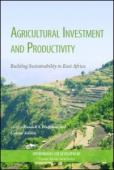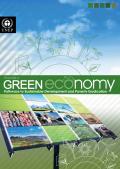
This book provides a deep and systematic look at the opportunities for and constraints to investments in sustainable agriculture in East Africa, offering important insights into what works and how to analyse agricultural investments in one of the poorest regions of the world.
The book critically examines the reasons behind East Africa's stagnant agricultural productivity over the past forty-five years, using the primary lens of investments in fertilisers, seeds, and sustainable land management technologies. These investment have a tremendous impact on production volume, ultimately affecting the income of millions of families throughout the region.
This book provides case studies on Kenya and Ethiopia.

The restitution of parkland to the Khomani San “bushmen” and Mier “agricultural” communities in May 2002 marked a significant shift in conservation in the Kgalagadi Transfrontier Park and environs in South Africa. Biodiversity conservation will benefit from this land restitution only if the Khomani San, who interact with nature more than do other groups, are good environmental stewards. To assess their attitude toward biodiversity conservation, this study used the contingent valuation method to investigate the economic values the communities assign to biodiversity conservation under three land tenure arrangements in the Kgalagadi area. For each community and land tenure arrangement, there are winners and losers, but the winners benefit by more than the cost that losers suffer. The net worth for biodiversity conservation under the various land tenure regimes ranged from R928 to R3456 to R4160 for municipal land, parkland, and communal land respectively for the Khomani San, compared to R25 600 to R57 600 to R64 000 for municipal land, parkland, and communal land respectively for the Mier.
New business models can make an important contribution to the transition to green growth. While some new business models involve large firms, others are small start-up firms that seek to exploit technological or commercial opportunities that have been neglected or not yet explored by more established firms. New firms tend to engage in more radical innovation than existing firms, and scaling up new business models can therefore help reduce environmental pollution, optimise the use of natural resources, increase productivity and energy efficiency, and provide a new source of economic growth. Although the market for green goods and services is growing, the development of new business models is affected by a range of barriers, many of which can be addressed by well-designed policies.
A green economy can be defined as one that results in improved human well-being and social equity, while significantly reducing environmental risks and ecological scarcities. It is characterised by substantially increased investments in economic sectors that build on and enhance the Earth’s natural capital or reduce ecological scarcities and environmental risks. These investments are driven or supported by national policy reforms and the development of international policy and market infrastructure.
Both fiscal policy and public finance can be key drivers of a country’s transition to a greener economy—or a brake on green growth and low carbon job creation. This paper explores the linkage and options available to policy-makers considering ways to drive and accelerate the transition to lowercarbon, more resource-efficient and socially-inclusive economic growth.

The Green Economy Report is compiled by UNEP’s Green Economy Initiative in collaboration with economists and experts worldwide. It demonstrates that the greening of economies is not generally a drag on growth but rather a new engine of growth; that it is a net generator of decent jobs, and that it is also a vital strategy for the elimination of persistent poverty. The report also seeks to motivate policy makers to create the enabling conditions for increased investments in a transition to a green economy.
The report includes chapters on the following areas:
- Agriculture
- Fisheries
- Water
- Forests
- Renewable Energy
- Manufacturing
- Waste
- Buildings
- Transport
- Tourism
- Cities
- Modelling
- Finance
